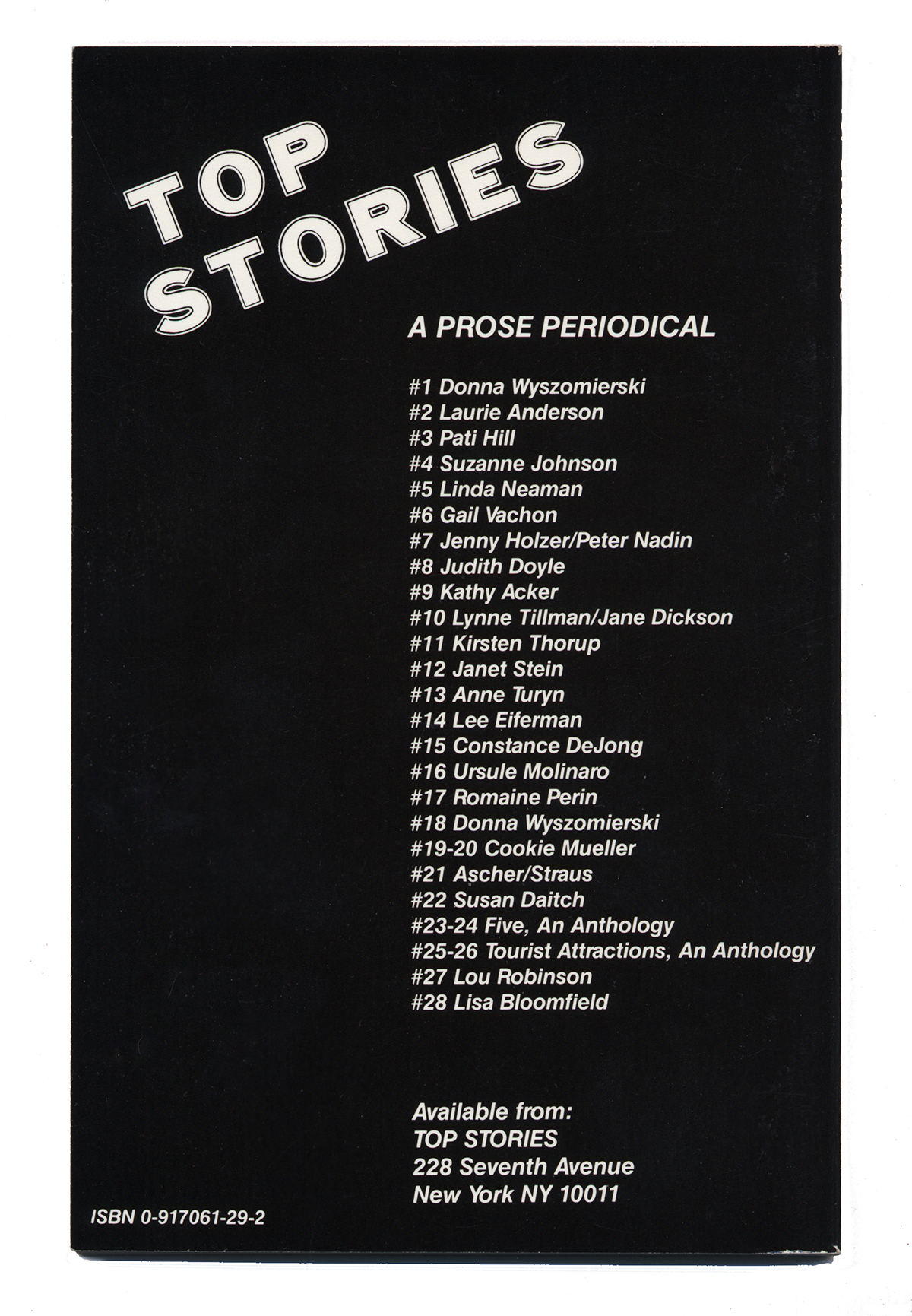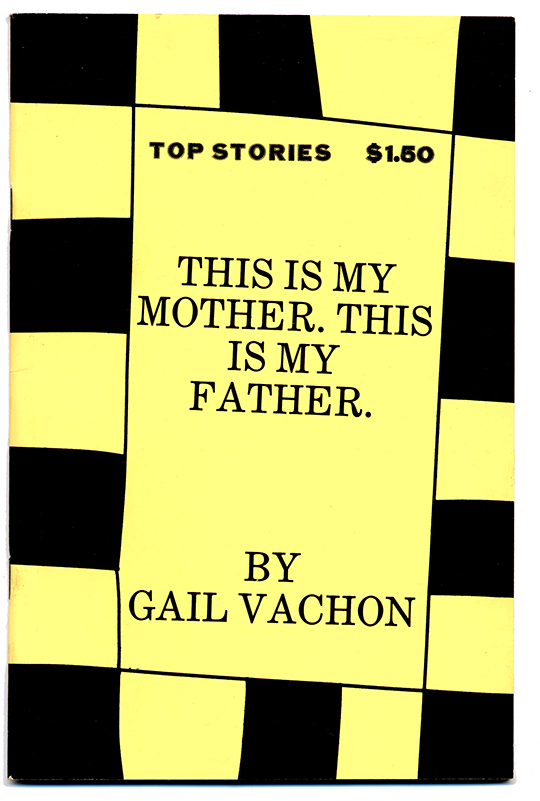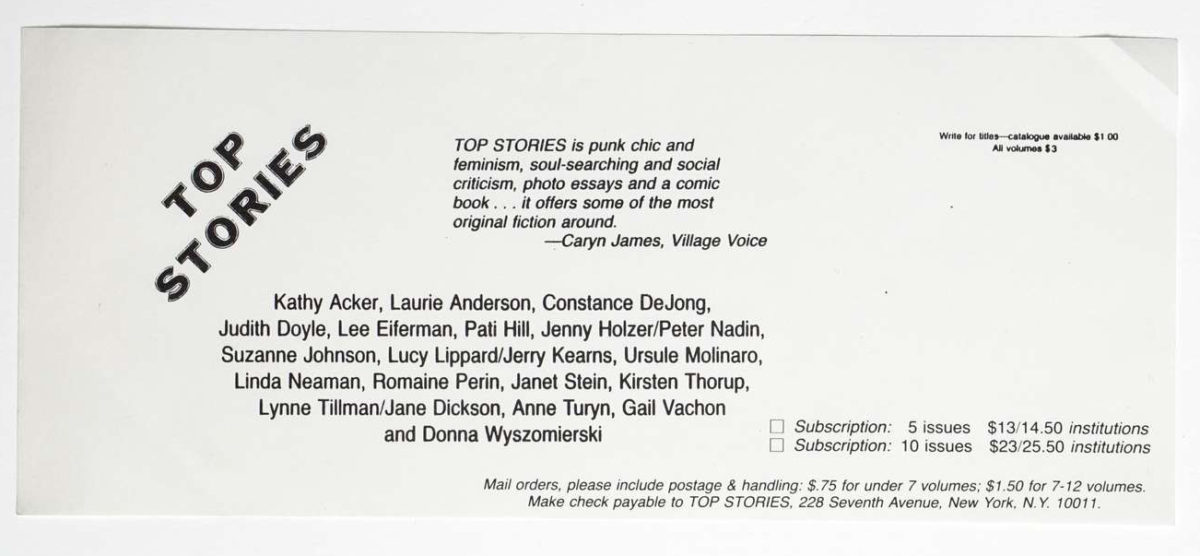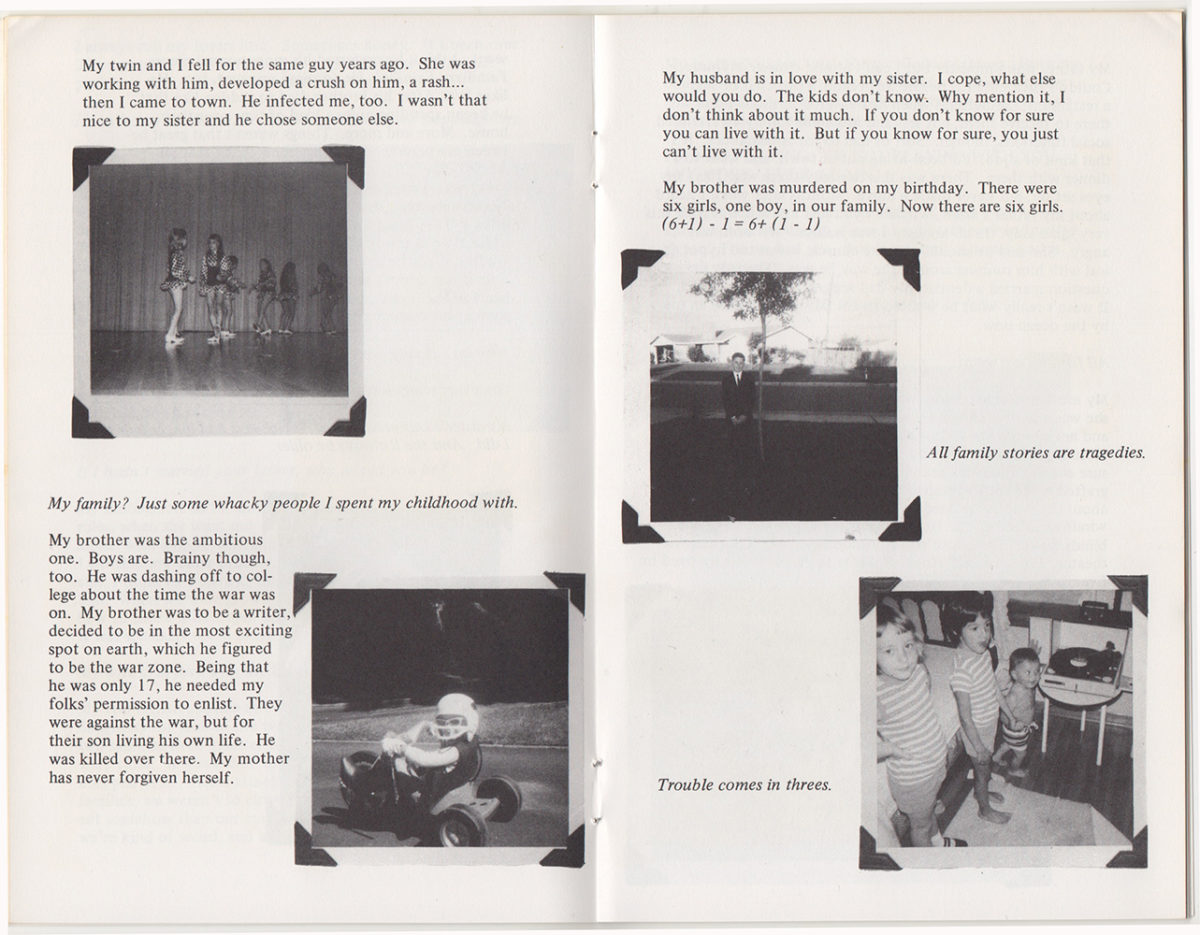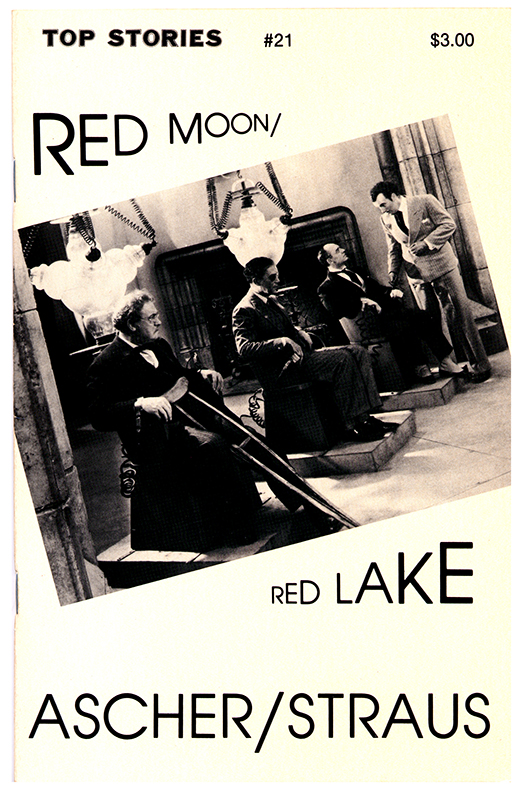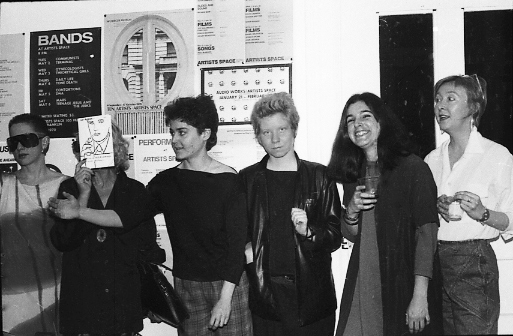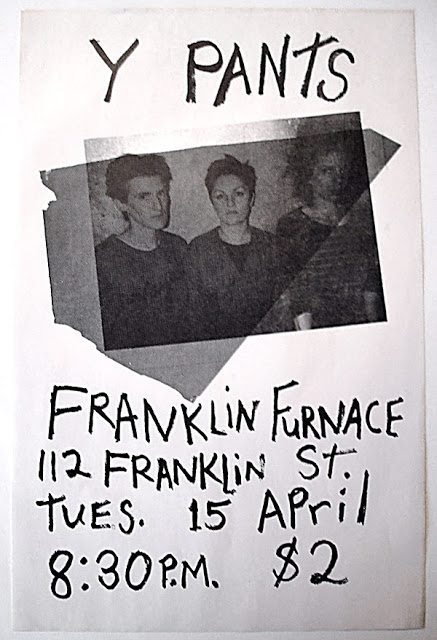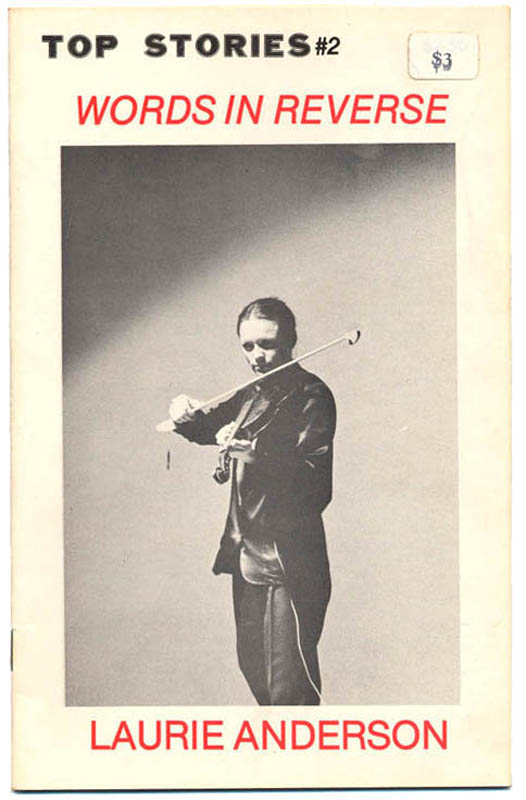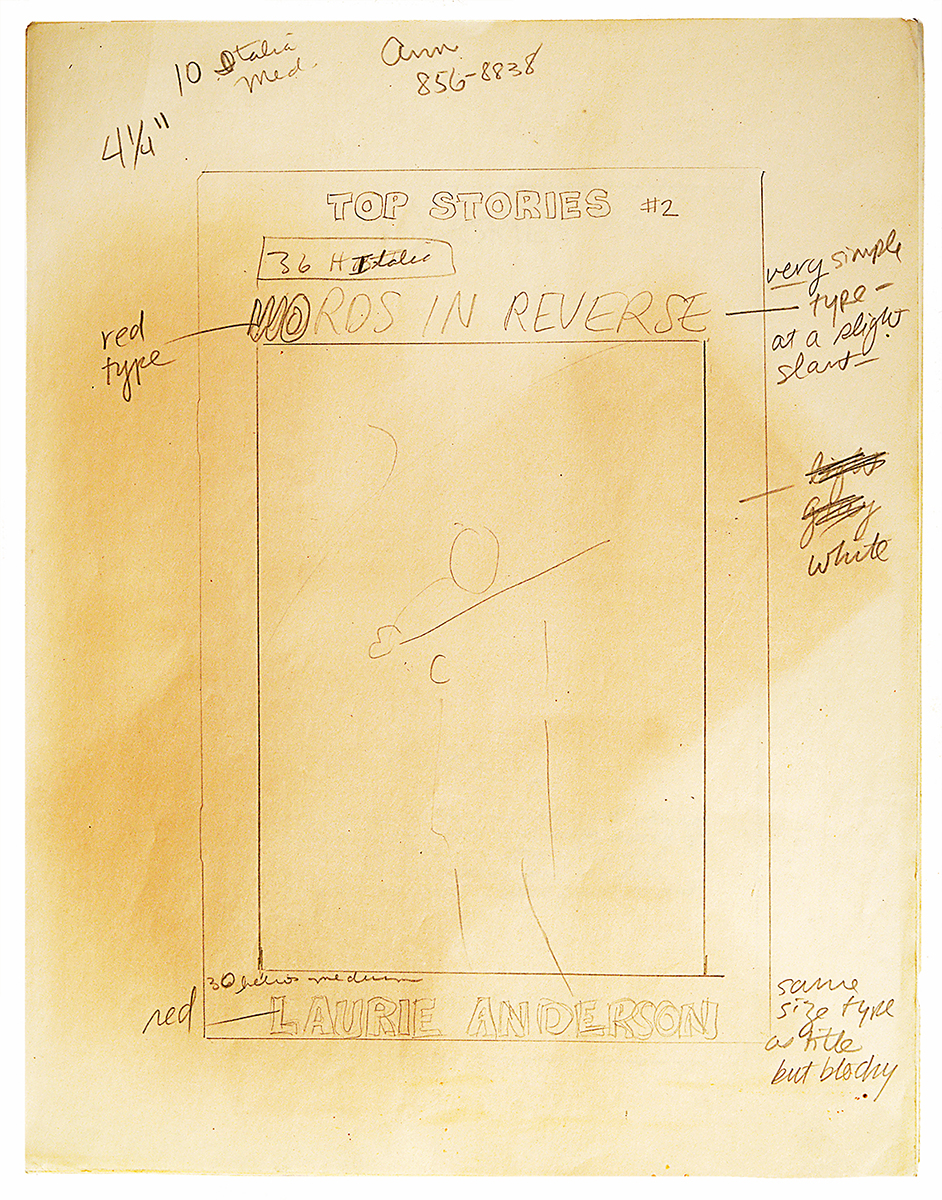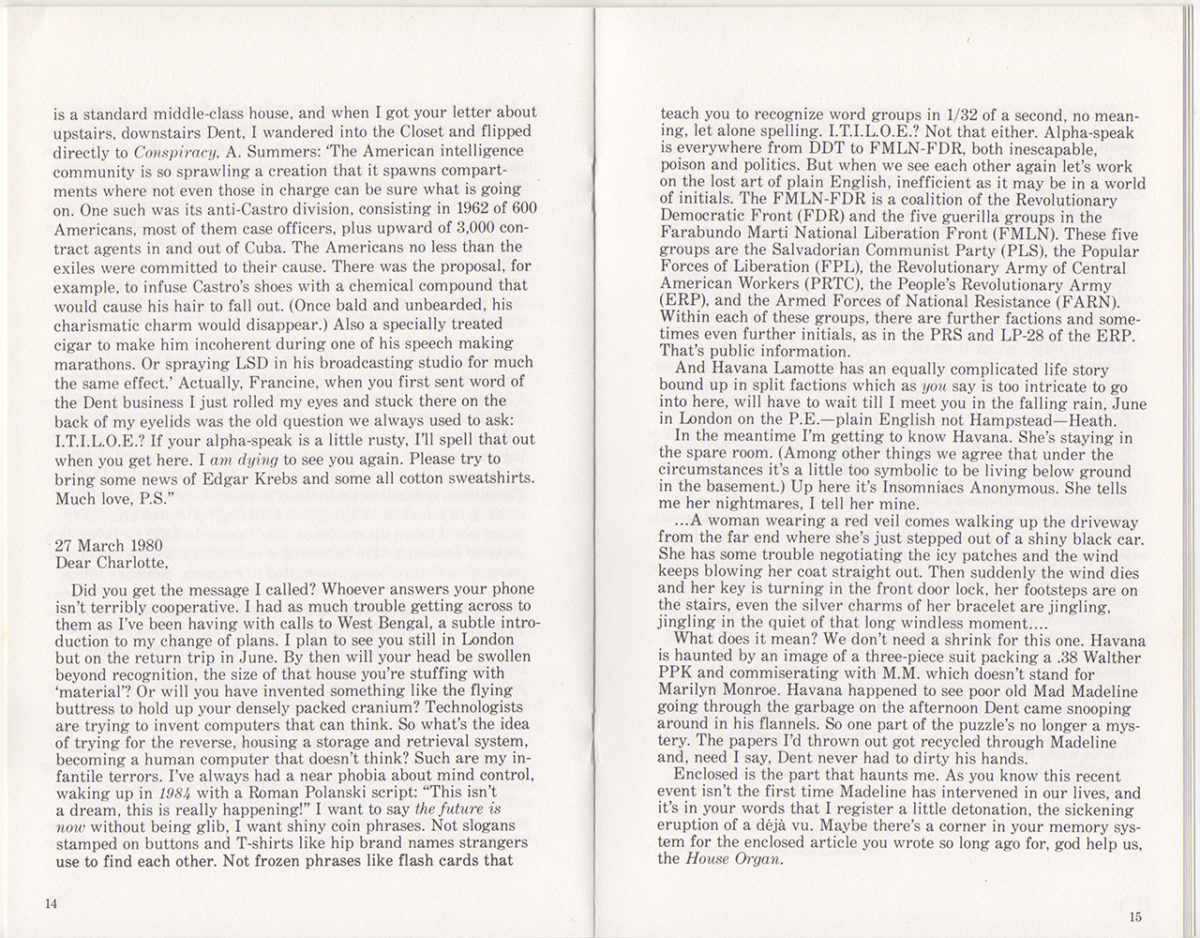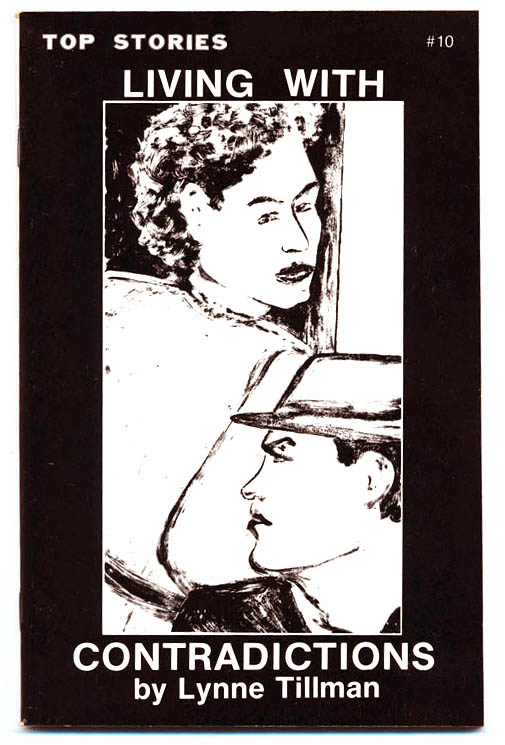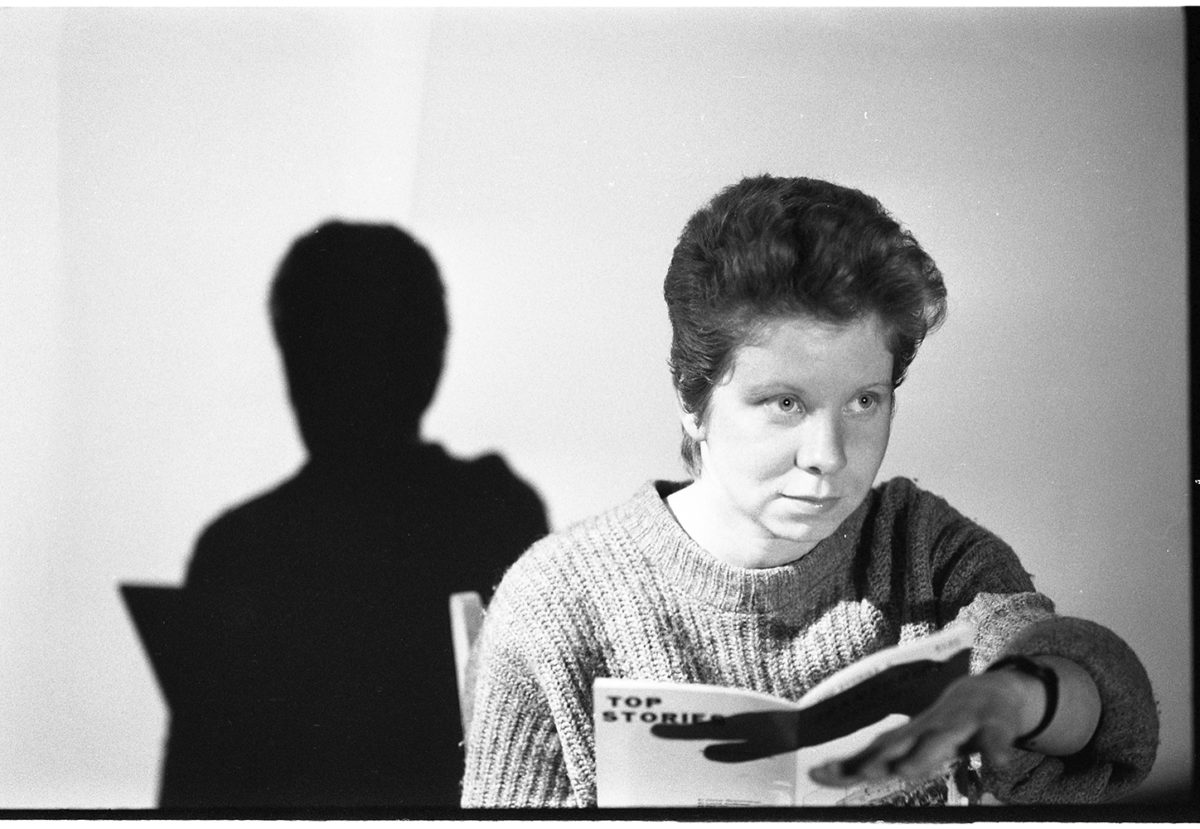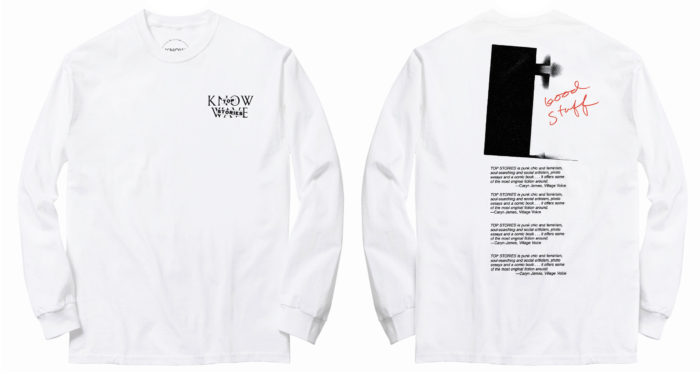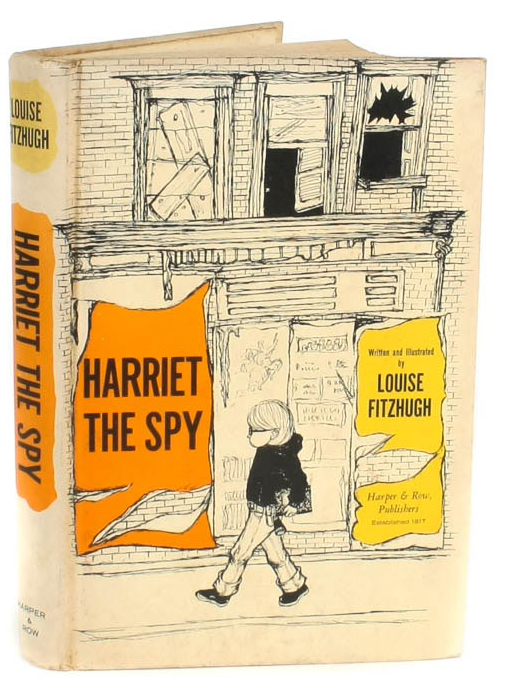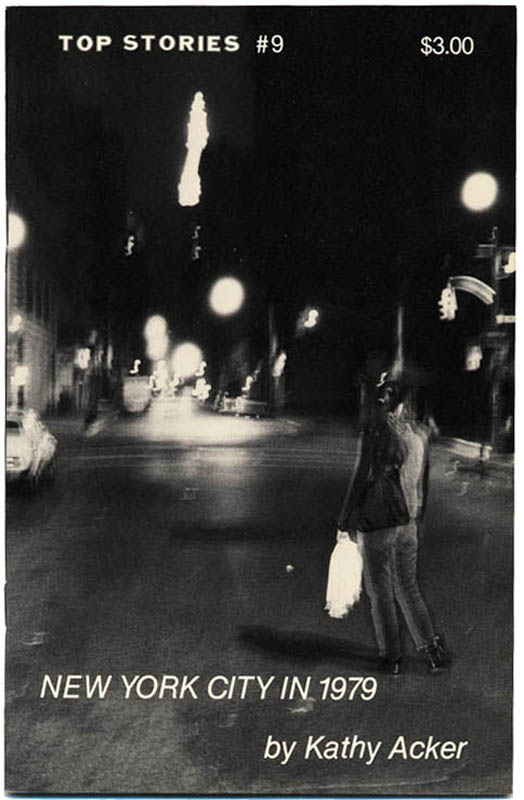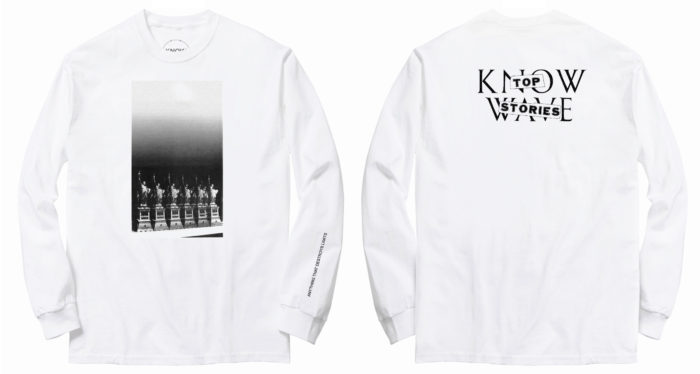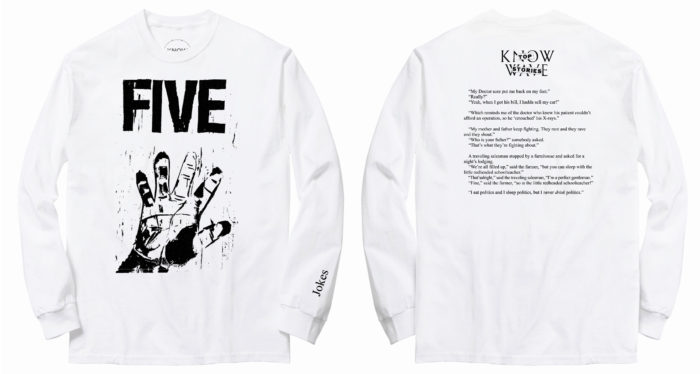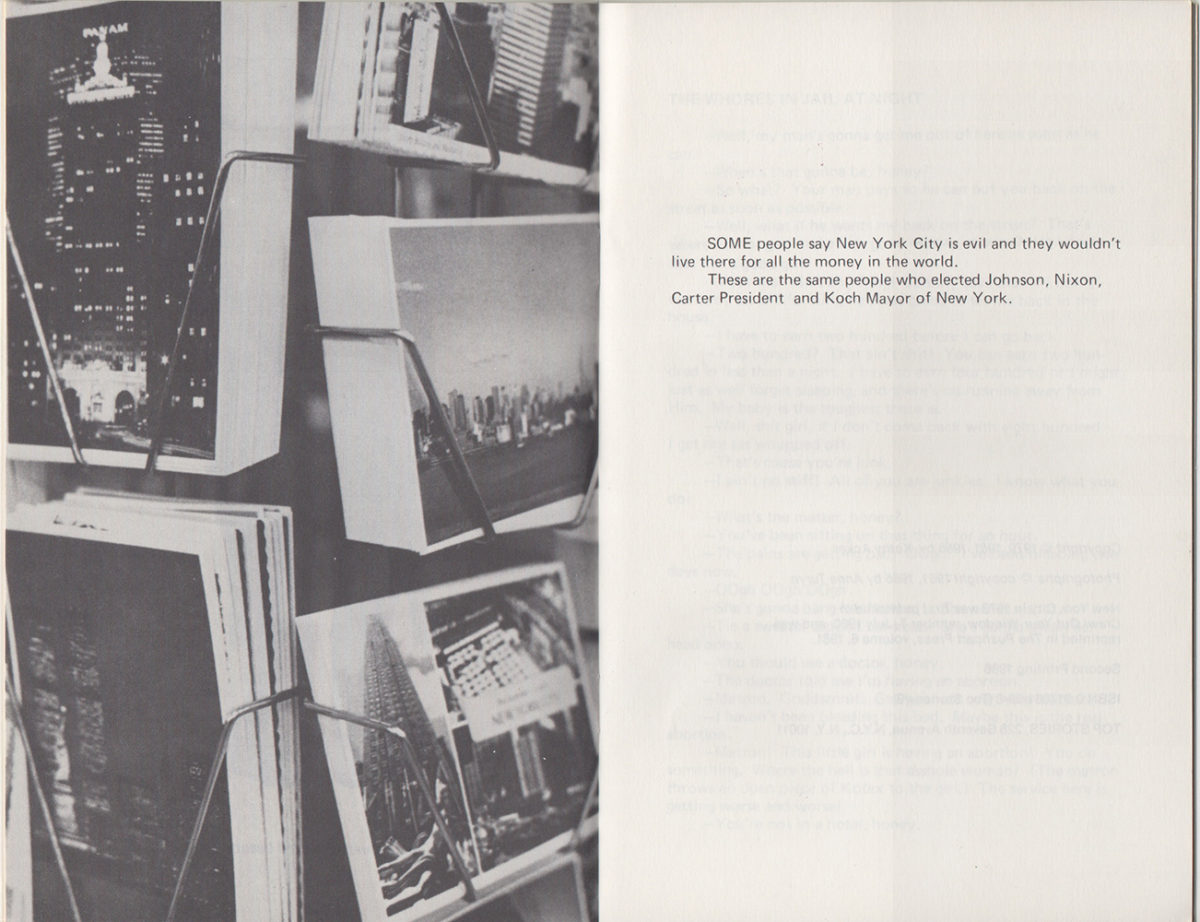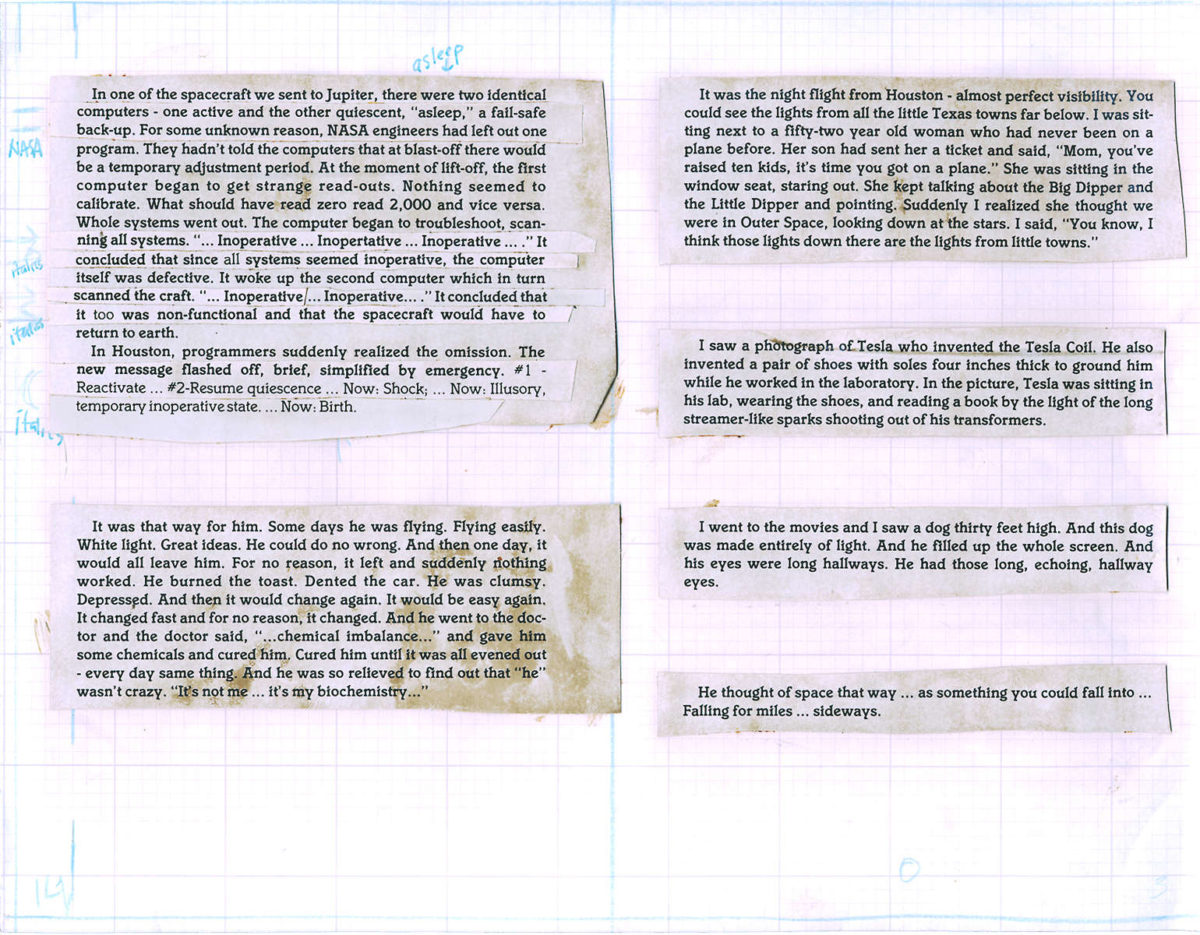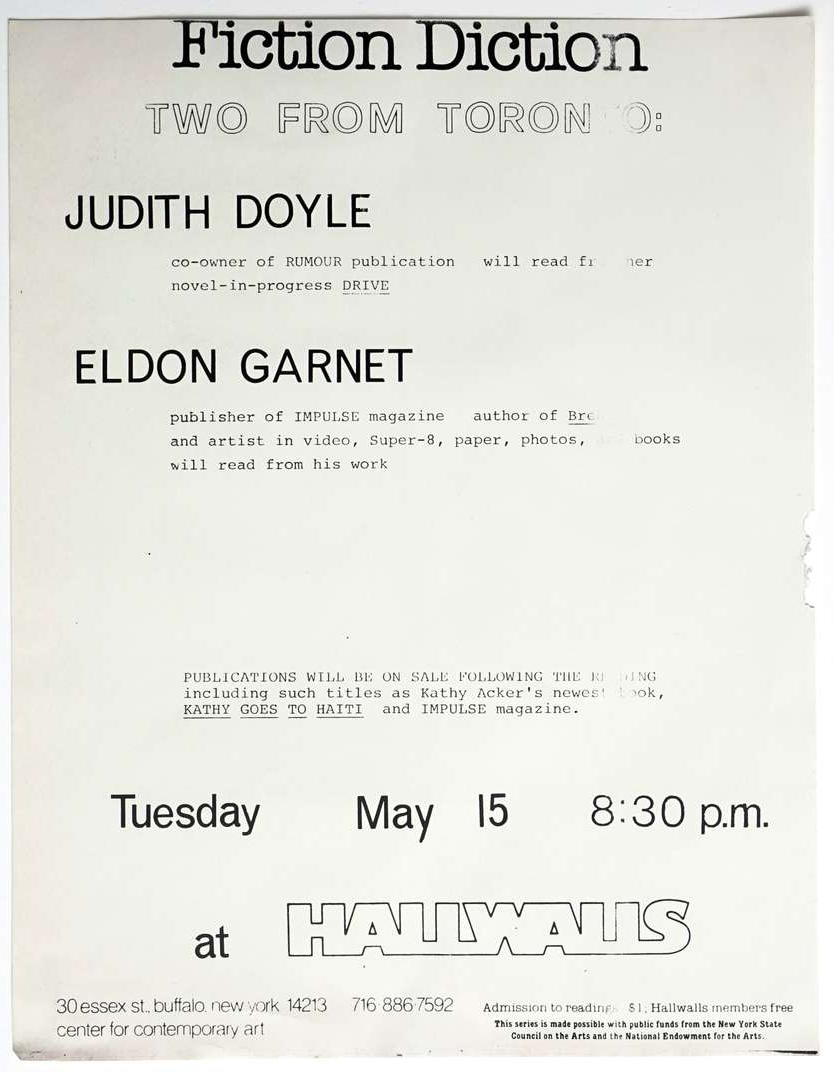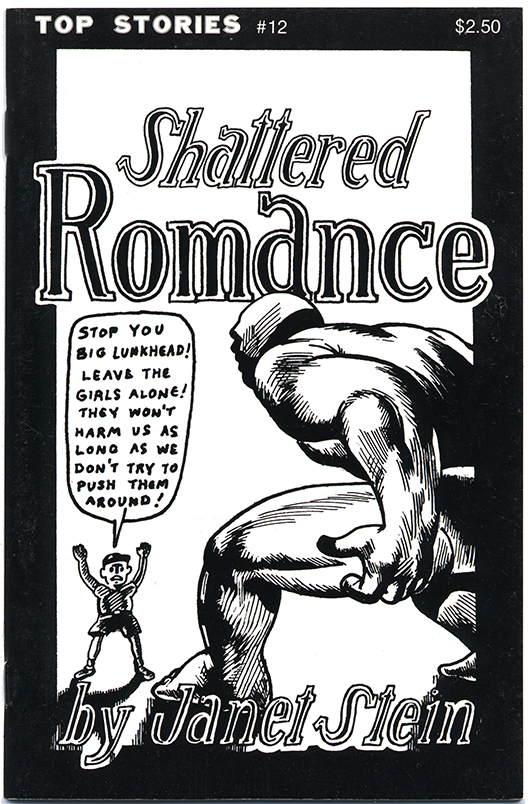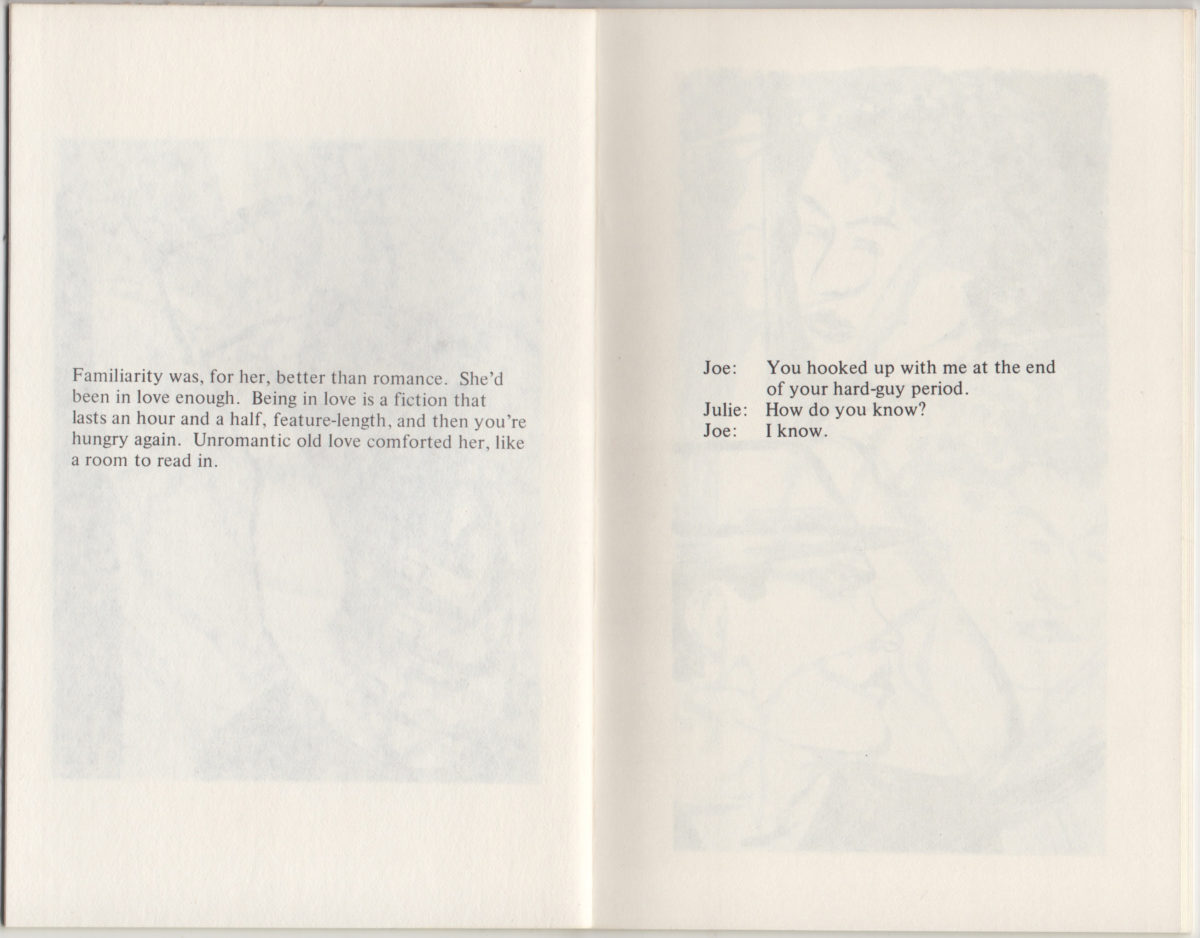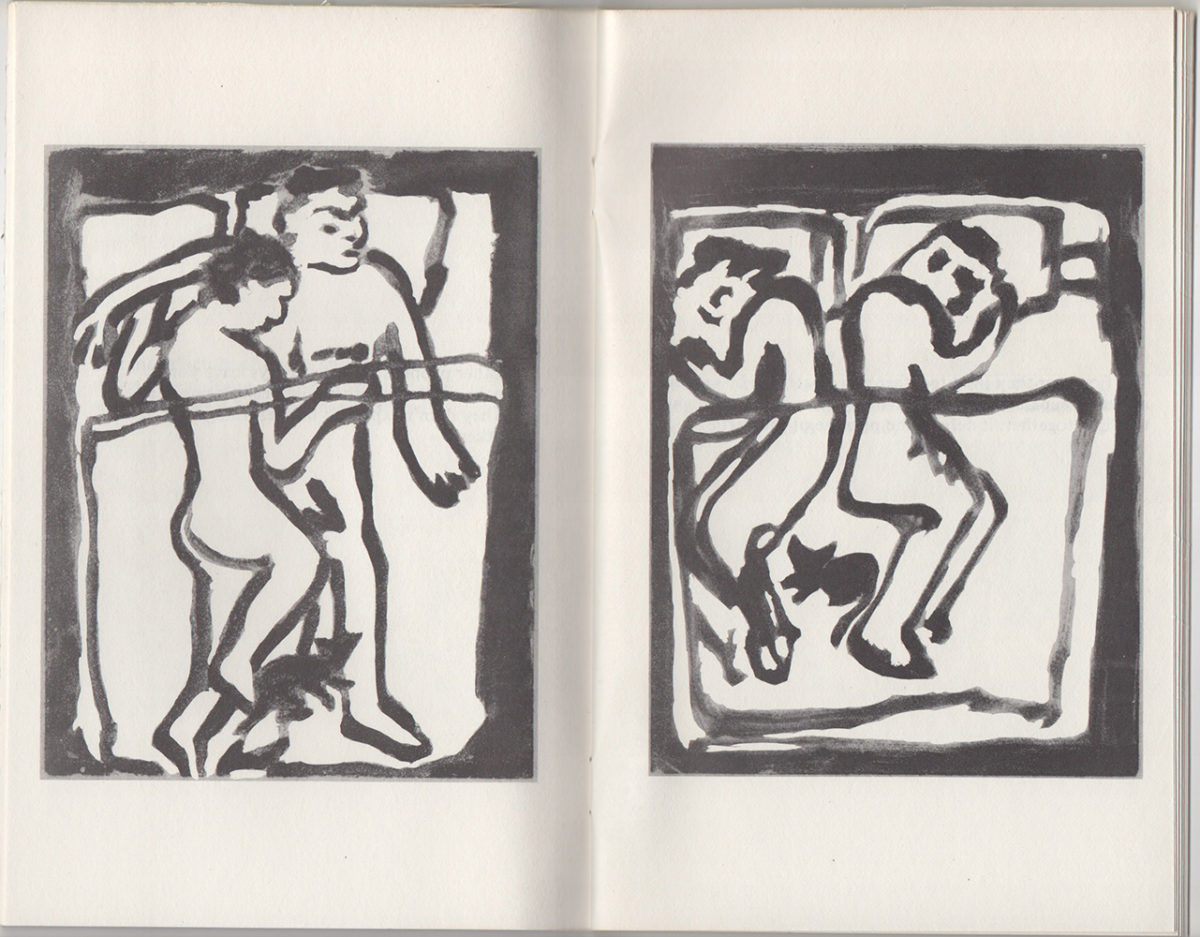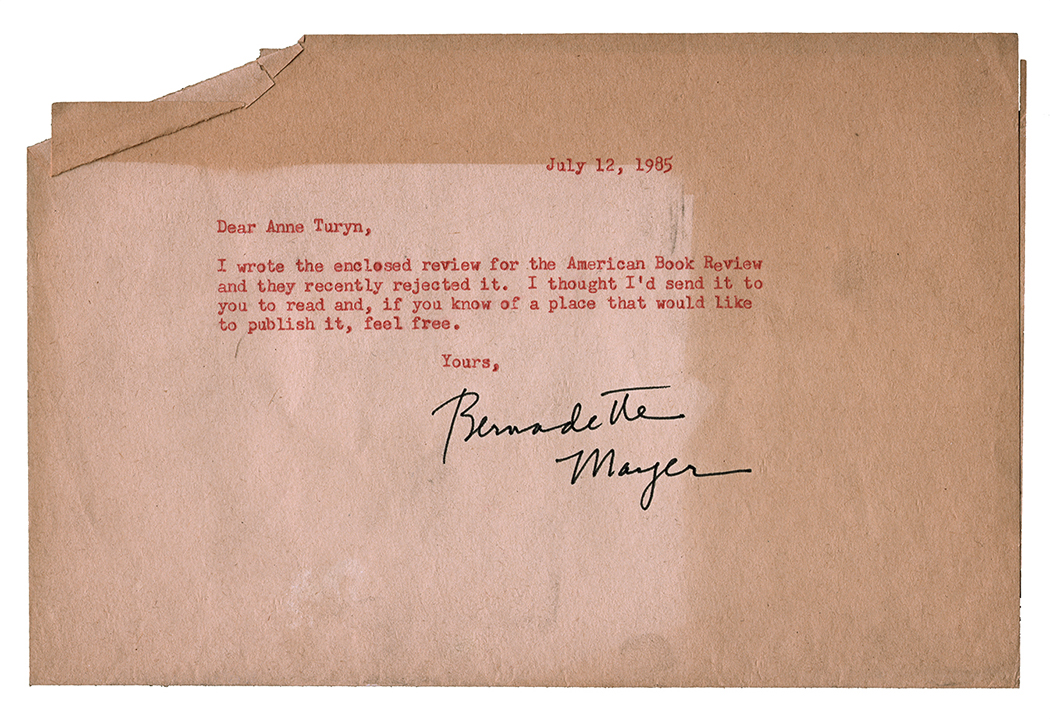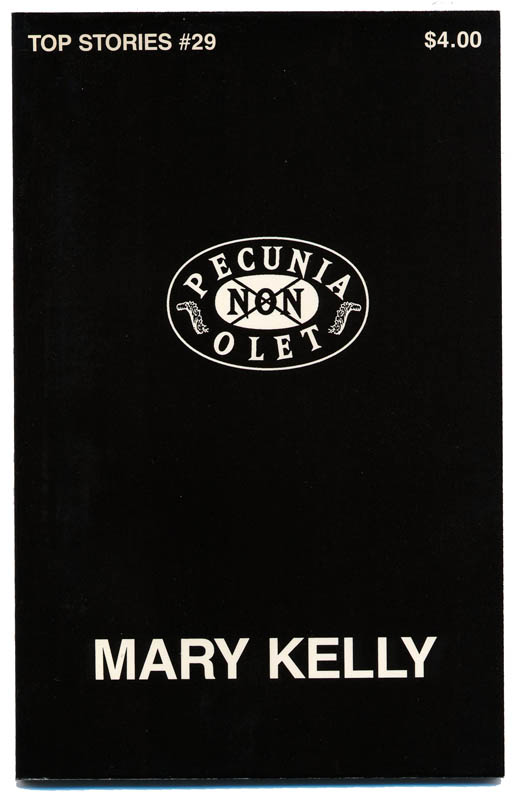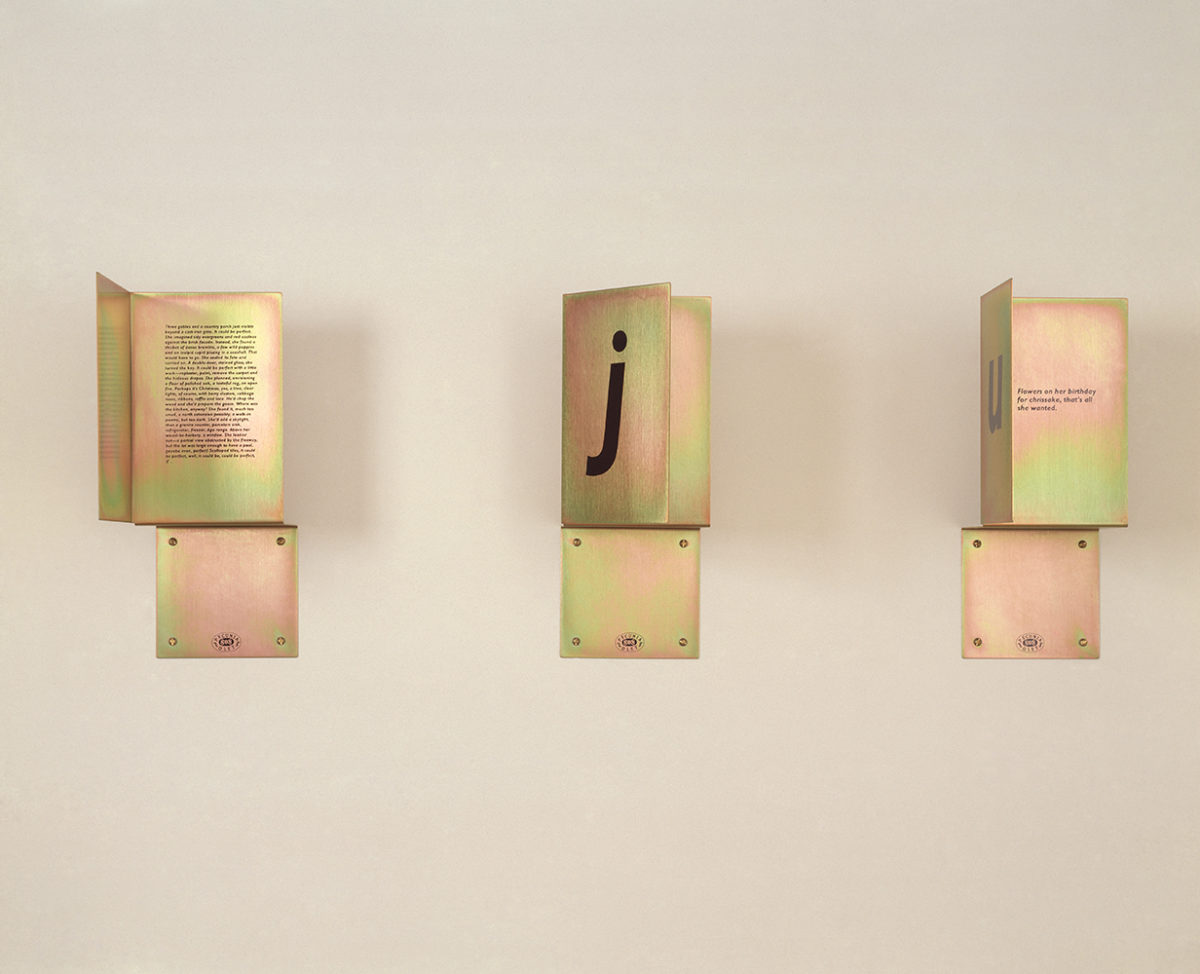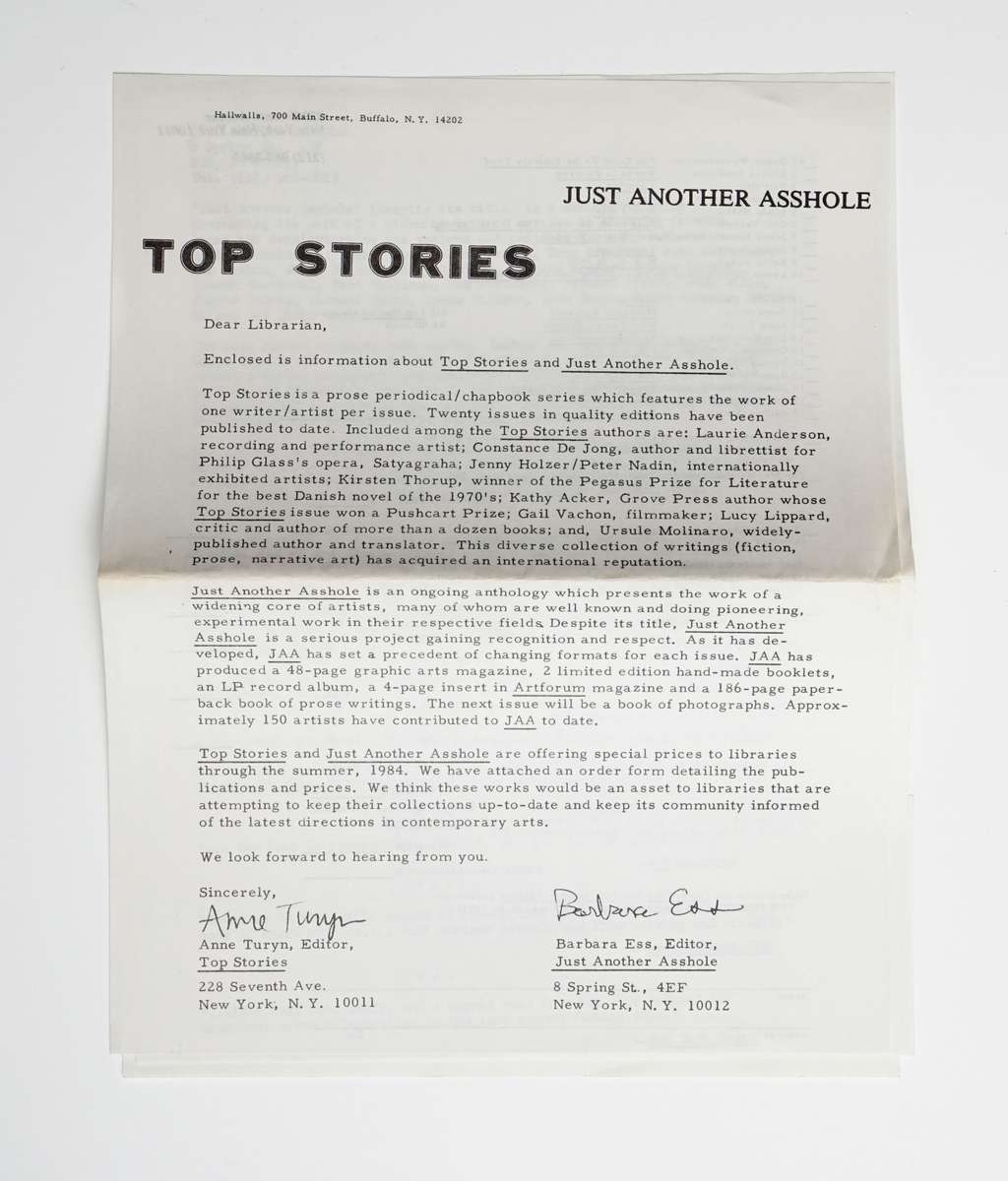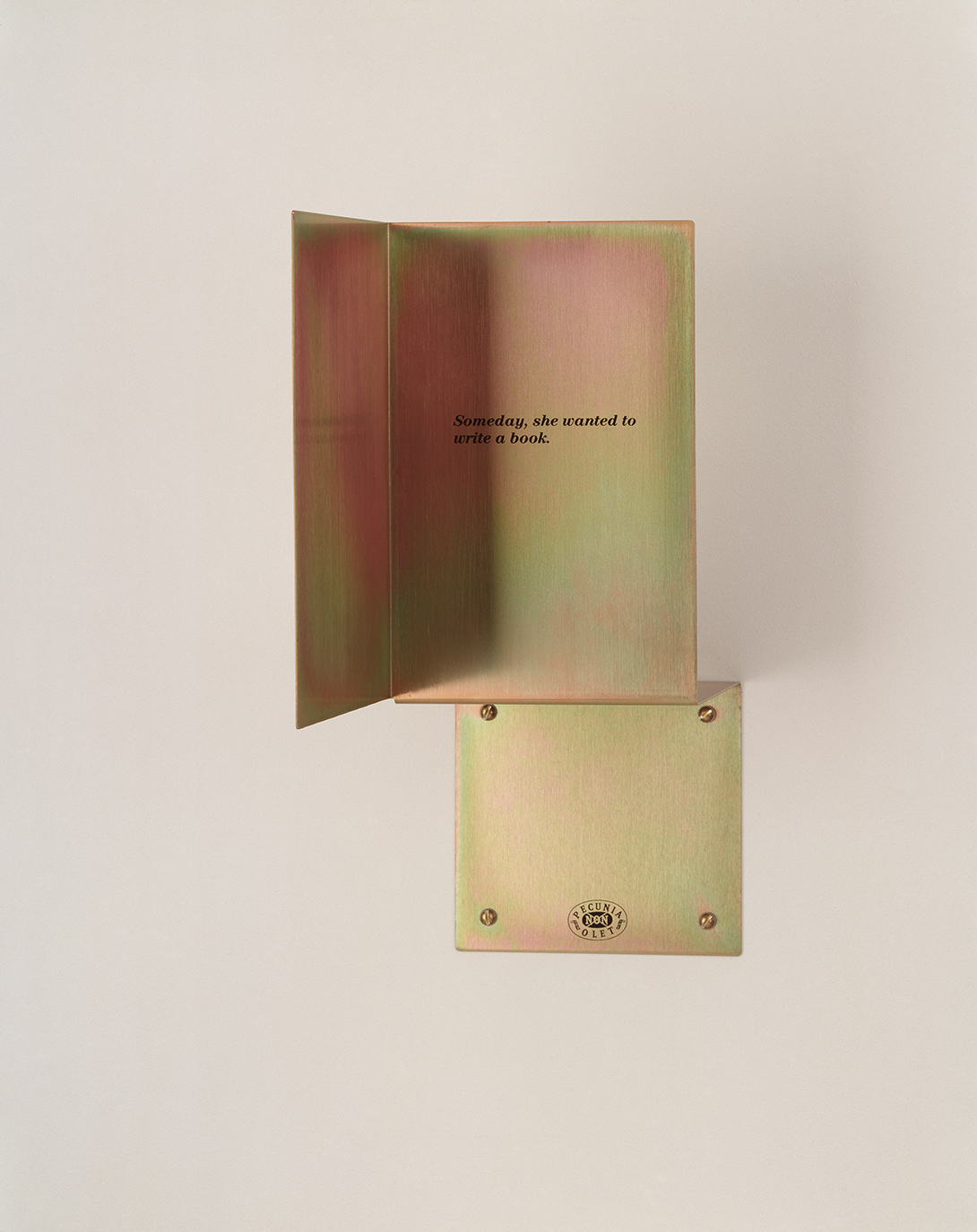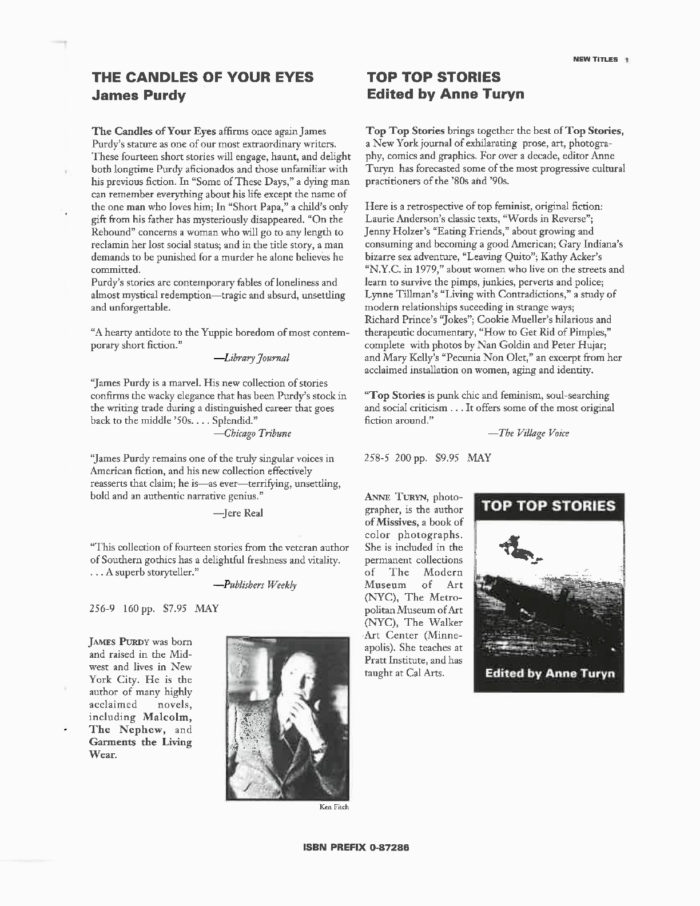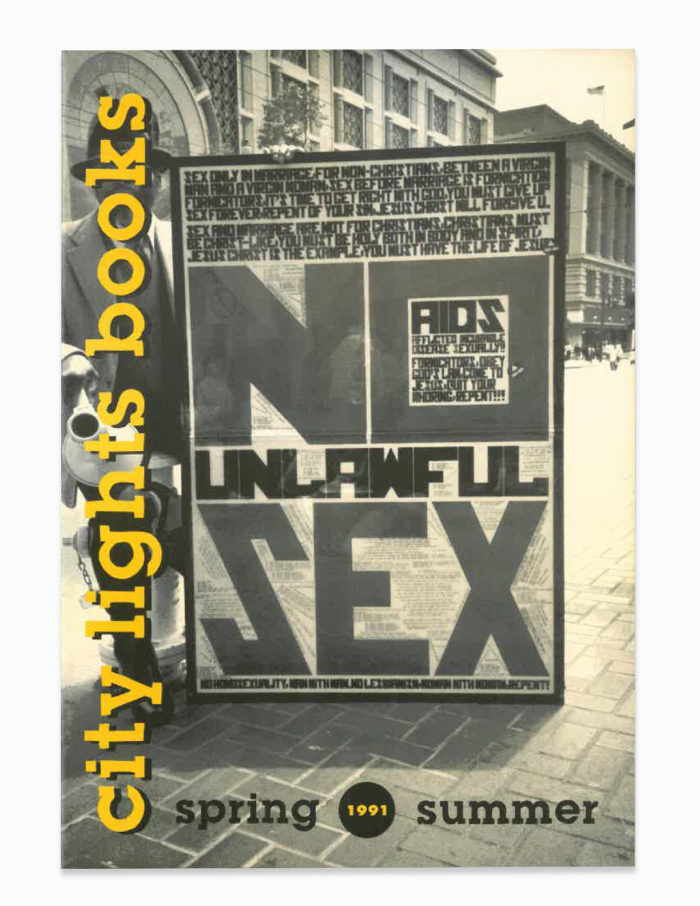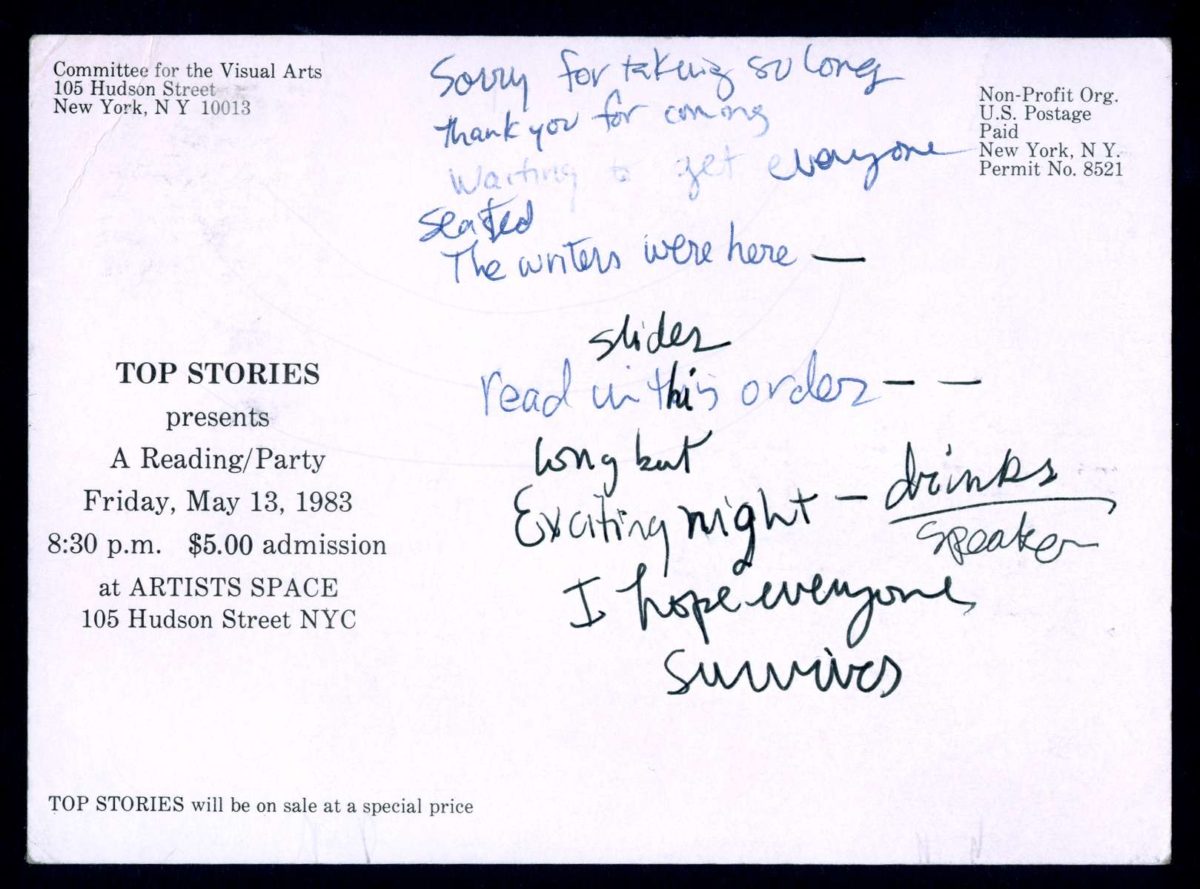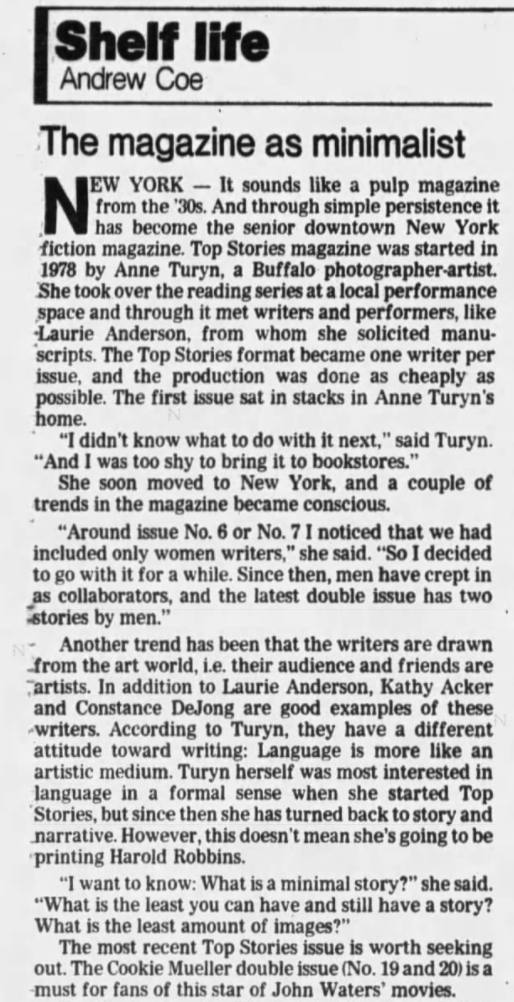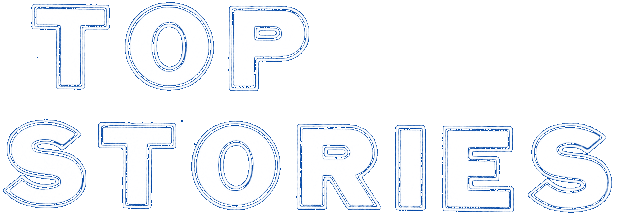
June 7 – December 31, 2021
Top Stories was a small press dedicated to radical forms of writing. Founded by Anne Turyn in 1978 when her longtime interest in non-traditional storytelling uncovered the inability and unwillingness of traditional publishers to support the growing number of artists working to push these boundaries. Over the next 13 years, Top Stories became an unparalleled venue for experimental writing, publishing small books by novelists, conceptual artists, filmmakers, and musicians. Included among its visionary participants were Kathy Acker, Laurie Anderson, Constance DeJong, Jenny Holzer, and Cookie Mueller.
A reflection of the restless language contained within each issue, Top Stories offered complete creative freedom to the participating artists. As explained by Turyn in 2018, “I’d print anything so long as their submission/piece fit in the 5×8” format, and the back covers were consistent.” This included shorter pieces, which would otherwise vanish into anthologies or journals; experiments in word and image; and texts drawn from larger bodies of work, performance scores or installations.
Turyn created a flexible, inexpensive format for publishing these cutting-edge works. Each issue of Top Stories was printed in black and white, with a stapled spine, in lengths ranging from 16 to 80 pages. They sold for as little as a dollar each, and never more than $6. They weren’t quite books and they weren’t quite pamphlets, but this in-between format manifested an intimate, direct relationship between text and reader that has sustained a steadfast fascination with Top Stories for more than three decades.
Today, issues of Top Stories are included in numerous archives and collections including the Museum of Modern Art, New York, and New York University’s Bobst Library. Top Top Stories, a single volume selection of works from Top Stories, was published by City Lights in 1991. Most recently, Top Stories has been the subject of exhibitions at Southfirst, Brooklyn, Weiss Berlin, Germany, and Kustverein, Amsterdam.
All images courtesy Anne Turyn unless otherwise noted
Top: Judith Doyle and Kathy Acker, from Top Stories at Artists Space, 13 May, 1983. Photo: © Laurie Neaman
Anne Turyn
Ascher/Straus
Constance DeJong
Jane Dickson
Judith Doyle
Mary Kelly
Janet Stein
Lynne Tillman
Gail Vachon
Jae Yeun Choi
Pablo de Ocampo
Hedi el Kholti
Elaine Katzenberger
Chris Kraus
Ariel Lauren Pittman
Amy Scholder
Brandon Stosuy
Anna Tidlund
“I had this idea to make a little publication where people could combine the kind of writing that I thought was interesting. I didn’t really even have a name for it. I just found writing that interested me, sometimes combined with images, and my friends all seemed to think it was interesting too. At the time it seemed like it was hard to find and so I thought I should publish it.”
– Anne Turyn, in a 2020 interview with Know Wave
Anne Turyn is a fine art photographer and educator. She was the founder and editor of Top Stories. Turyn’s Real Family Stories was published by Top Stories in 1982.
“The person who started Top Stories was a reader. She had a mind that read outside of conventionally published narrative. And she was a great person for this project, because of the truly inquisitive, interested, curious mind she has. I mean, she was devoted to the medium of language.”
– Constance DeJong, in a 2020 interview with Know Wave
Constance DeJong is an artist, writer and performer. DeJong’s I.T.I.L.O.E. was published by Top Stories in 1983.
“I absolutely loved those books. I remember being really struck by Gail Vachon’s This Is My Mother, This Is My Father, I can still remember whole lines of that piece. At the time, I didn’t know any of the writers personally but they were clearly part of a larger affinity group, aesthetic or community. They were all female, they favored the first person, they weren’t confessional, they were prose, they weren’t plot-driven like traditional short stories, they were tough.”
– Chris Kraus, in a 2021 interview with Know Wave
Chris Kraus is an artist and writer, and a co-editor of Semiotext(e). In 1990, she founded Native Agents, an imprint of Semiotext(e), which published books by Cookie Mueller, Kathy Acker, Lynne Tillman, and Gary Indiana, among others.
“Looking back at Top Stories after 38 years has passed, I’m impressed with how visionary they were. They’re authentic records of the times, they documented the culture that went against the grain. They broached dialogue and exposed ideas, and I guess reinforced and inspired anyone who was feeling strangled by the status quo. It did feel helpful to have someone recognize and wish to record my work.”
– Janet Stein, in a 2020 interview with Know Wave
Janet Stein is an artist. Stein’s Shattered Romance was published by Top Stories in 1982.
“I really was just approaching Top Stories like, what can a little book do? What can words and pictures do? I like fiction that isn’t regular, you know what I mean?”
– Anne Turyn, in a 2020 interview with Know Wave
“We were aware of Top Stories as unusual and appealing for at least two reasons. Our work through that point had one foot clearly over the line from traditionally published fiction into installation art and ideas floating in the atmosphere from Fluxus and related philosophies of the ephemeral. So a publishing entity that seemed to straddle a similar line attracted us. And, just as important and possibly a contradiction, but still true, was to find that fiction — narrative fiction — seemed to matter to Anne and to Top Stories was extremely important to us, because no matter how extreme some of our language experiments were then the bedrock for both Sheila and myself — something we would always return to and which came to be the center of our writing lives with time — was and is narrative fiction. We loved narrative fiction, we studied it, we wrestled with it, we wanted to make it new and to re-think basic truths about what it could do, but we never stopped loving narrative and then and now that was a distinct separation from a tremendous amount of alternative writing in the downtown world and everywhere.”
– Ascher/Straus in a 2021 interview with Know Wave
Ascher/Straus=Sheila Ascher & Dennis Straus. Their Red Moon/Red Lake was published by Top Stories in 1984.
“If you look at the range of Top Stories, there’s a lot of different aesthetic trajectories there. It’s not a group of friends. It’s people that Anne found interesting, and it’s a really wide range.”
– Judith Doyle, in a 2020 interview with Know Wave
Judith Doyle is a filmmaker, writer and educator. In 1978, Doyle and Fred Gaysek co-founded Rumour Publications, which published books by Kathy Acker and Judith Doyle, among others. Doyle’s Transcript was published by Top Stories in 1981.
“Anne I think clearly was the glue for very disparate visions of how to write and how to live.”
– Ascher/Straus in a 2021 interview with Know Wave
“Writing is a solitary occupation and so is reading. But we were aware of each other. Most of us were not primarily writers.”
– Gail Vachon, in a 2020 interview with Know Wave
Gail Vachon is a filmmaker, musician, and artist. Vachon’s This is My Mother. This is My Father was published by Top Stories in 1980.
“I often think about how a lot of people in the scene dabbled in a number of places. Like, how Richard Hell started as a poet, became better known for his music, and has now returned to focusing on writing. I think because people were bringing different areas of experience to their writing, it led to this kind of experimentation.”
– Brandon Stosuy, in a 2021 interview with Know Wave
Brandon Stosuy is a curator, writer, and historian. His book Up Is Up But So Is Down: New York’s Downtown Literary Scene, 1974-1992 was published by NYU Press in 2006.
“I lucked into a job doing computer typesetting in the advertising department of Bloomingdale’s. I didn’t know what I was doing, but I was on the night shift, so there were no bosses around to check on me, and I figured it out soon enough. And because I was on my own, I was able to typeset other things. I don’t remember which issues [of Top Stories] I did, definitely my own, and probably others around the same time.”
– Gail Vachon, in a 2020 interview with Know Wave
“It was a less professionalized time. There were so many things that we were just winging, that now you have to get a degree to do, and all these professionals have taken it over.”
– Jane Dickson, in a 2020 interview with Know Wave
Jane Dickson is an artist. Dickson’s collaboration with Lynne Tillman, Living With Contradictions, was published by Top Stories in 1982.
“I treated the end thing, call it a publication or a book, the way one makes art. You do everything all the way though, and then it’s done. I’m not a person who makes a manuscript and then gives it away for someone to do something with. I learned that early on in Modern Love. So working with Anne, a person who did everything, just made all the sense in the world to me. Yes, this is how I like to work.”
– Constance DeJong, in a 2020 interview with Know Wave
“The only guidelines were the size and the shape. It was more about what I could afford. Like the first ones were 16 pages because it seemed like I could afford that.”
– Anne Turyn, in a 2020 interview with Know Wave
“The idea of my not doing what I wanted to do, not writing what I wanted and how, changing my nascent fiction because of an editor’s demands—that hadn’t occurred to me. Writing was a freedom for me. The only complete freedom I had, I thought. I’m still pretty uncompromising, for better or worse til death etc.”
– Lynne Tillman, in a 2020 interview with Know Wave
Lynne Tillman is a writer and critic. Her collaboration with Jane Dickson, Living With Contradictions, was published by Top Stories in 1982.
“What was unique about Top Stories, and what I shamelessly copied in the Rumour series, is that there was a single contributor for each publication. That allows a person to present their own work as a solo effort. Even if it’s tiny. It was about reaching out and creating a very particular kind of contemporary and conceptual space. There was something contemplative about the format of Top Stories, I think. You just imagine yourself sitting in a chair with that small pamphlet, it feels like you are 100% engaged with that author.”
– Judith Doyle, in a 2020 interview with Know Wave
“They feel like each one contained an idea. So they were book-like, even though they weren’t book length, and I think that’s why I liked them so much. Because it really was entering into a world and a sensibility.”
– Amy Scholder, in a 2021 interview with Know Wave
Amy Scholder is a producer, editor, and publisher. As an acquiring editor for City Lights Books, Scholder proposed and developed the book Top Top Stories, 1991, an anthology compiling seventeen works originally published by Top Stories.
Good Stuff L/S T
$65
Order Now“I read an interview with Kathy Acker in Only Paper Today and that was the first I learned of Kathy Acker. She was talking about point of view and changing narrator. I had been through Faulkner and Kesey, and I was really interested in point of view as a young person. As an eleven-year-old I had one of those intellectual moments. Do you know the book Harriet the Spy? That came out when I was about that age. I don’t know how I would have heard anything about it when I was eleven, I just looked through books at the Scholastic fair until I found that cover. And I pretended I was sick the next day to stay home so I could read it. I realized there were three ways that you know what’s going on in the story – by what the omniscient narrator’s saying, by the conversations between characters, and by what’s in Harriet’s diary. That’s something I never got over: this idea that the language and form of the novel is plastic.”
– Anne Turyn, in a 2020 interview with Know Wave
“I think what I loved about Kathy’s work and the Top Stories volume, New York City in 1979, in particular, is that it’s playing with that idea of what’s fiction and what’s your own story. It’s playing with this idea of how to create an emotional arc when you’re writing about things like gentrification, patriarchy, the evils of capitalism and how those are impacting her female body in the world. So the fact that it was funny and sexy, while also contained all of these ideas was what made me a fanatic wanting to read more of Kathy and want to read more of whoever published Kathy. And that’s how I went down that rabbit hole of collecting all the Top Stories.”
– Amy Scholder, in a 2021 interview with Know Wave
“Kathy was living in San Francisco at that point and she asked me to get some New York photographer to take some photos to go along with her issue. I started asking friends, thinking that different people could each put a photo in, like a compilation. And Linda Neaman, who did Top Stories #5, she was a friend and always helpful and critical with me. She said, ‘Why don’t you just do it?’ So I went out, having studied the text, specifically for these photos.”
– Anne Turyn, in a 2020 interview with Know Wave
“I was against street photography at that point, it was the tradition that I was rebelling against. That was what the old guard did. I was really not interested in the illustrative kind of relationship with photos and texts. But I went out, having studied the text, and took those photos. It wasn’t anything I continued doing, but a couple of years ago I got out those negatives, I probably hadn’t looked at them since 1981. I hate to say it because it’s my work, but I love those photos now.”
-Anne Turyn, in a 2020 interview with Know Wave
“I don’t think Anne Turyn’s willingness to take the photos was all that unusual. Among people who are really into a project, into a collaboration, pretty much anything goes. It’s the turgid professionalism that makes spontaneous actions impossible that seems strange to me.”
-Chris Kraus, in a 2021 interview with Know Wave
“I actually didn’t take English classes in college. So even though I loved to read, I didn’t have that background. I didn’t go to Catholic school where you learn good grammar, parsing sentences and that kind of stuff. So when Laurie Anderson sent hers, I thought that some of the punctuation was wrong. I was living with Tony Conrad, and I said to him, ‘I don’t know if this is right?’ and he replied, ‘She’s an artist! You can’t change it, don’t change anything.’”
– Anne Turyn, in a 2020 interview with Know Wave
“I was a struggling artist trying to get by honestly. I worked at all kinds of part time jobs and relished the irony I found and found it all fit material for the way I was processing things. Being a young woman, my perspective was colored by the types of confrontations and challenges that existed then, for me and for my peers. Being reclusive, introverted and with a rebellious streak, I didn’t know how to find a gallery to sponsor me. I wanted to do something that had some social value.”
– Janet Stein, in a 2020 interview with Know Wave
“What we were feeling at that moment was that the art world was a very closed system of minimal conceptualism. And the one thing that all these people, all my friends shared, was an interest in content. So we felt like we were never going to get shows anywhere, and we were going to have to make our own opportunities.”
– Jane Dickson, in a 2020 interview with Know Wave
“I was making the work I did for the small downtown community and never imagined it would go beyond that. I thought Anne had tremendous foresight to organize and publish all of these people, of this particular milieu.”
– Janet Stein, in a 2020 interview with Know Wave
“Jane had asked me to write a story based on her drawings of her and Charlie, her husband, living together, life as a couple. She knew I lived with David Hofstra, a bass player, so I had some experience of it. I spent six months or so working on it… When Jane read the story, I believe she was disappointed, maybe she had expected something more story-like. Mine was told in fragments, a meta-story really. She didn’t like it, then. But I did, and her drawings. And thought Anne Turyn would, given what she had already published. We were both studying at CUNY Grad School, I think that’s where I met her. We weren’t friends then, just acquaintances. So I gave it to her, she loved it and Jane’s drawings, and wanted it for Top Stories.”
– Lynne Tillman, in a 2020 interview with Know Wave
“I’d been doing a little of this, a little of that, and I made myself a resolution that from now on, I’m only going to make art about things I actually know something about. That I felt I had something to say about. So making that resolution, I looked around and thought, ‘What do I actually know something about?’ Well, I spent all my time with my girlfriends talking about guys. ‘Oh my god, we went on a date and you can’t believe it, he did this?’ or ‘We’re living together and he won’t do that.’ It was like we were trying to tame leopards. At the point when I did those mono prints, in late 1979 or early 1980, I was living with Charlie Ahearn, who I’m still living with, but it was new at that point. So I thought: I’m just going to start making these sketches of daily life, living with a guy. This was the first person I had actually lived with, long term, so what does it consist of? There’s a pair of drawings in there, where the good night is them curled together, and the bad night is we’re facing opposite ways. They were my first works where I’m grappling with what I actually knew about.”
– Jane Dickson, in a 2020 interview with Know Wave
“I wasn’t ever sure: Was it literature? Or was it artist books? I though it was literature, but the world wasn’t ready for literature like that, right?”
– Anne Turyn, in a 2020 interview with Know Wave
“I was so thrilled to be asked by Anne to do it, because I never really thought of myself as a real writer. I was writing, using it in the artwork, but I would use different kinds of genre. I didn’t think I had my own style, I thought I was adapting it to the work.”
– Mary Kelly, in a 2021 interview with Know Wave
Mary Kelly is an artist and writer. Kelly’s Pecunia Non Olet was published by Top Stories in 1990.
“The book form is kind of time-based. There is a beginning, a middle, and an end, and you do have to work through it in that way. This is not the way the installation works at all. In fact, what I love about installations is that they’re very self-reflexive. You don’t have to follow that logic. The artist can set it up, which I do, but you don’t actually take it in the same way that you do in the book. The typeface, the scale, and the material are so important in the work because I always assume people are only going to read, you know, a few bits of it. So having the larger letters in that typeface that give these categories or agencies of the woman, and then you have the anecdotal phrases at the end of each one that people might catch. They might catch the look of an ad, and they might read some of a story. But I think the way that the meaning is made, if you want, in that situation, is very different from the book. And one of the things that the book did, for me, is it made me read my own work. Very brutally. And there was something rewarding about that, because there it was from beginning to end. So much work is put into the writing, and it’s not exactly lost, in the installation, but it is supplemented by the phenomenological aspects of that encounter.”
– Mary Kelly, in a 2021 interview with Know Wave
“In the actual piece, Pecunia, it’s made of a kind of iodized steel, with a shiny, metallic surface. I think of the affect of a kind of sentimentality that you find in greeting cards. It was already the scale of a book or a card that you opened, but of course you lose the texture and the affect of that shiny surface. You lose the dimensionality. So it’s never really comparable.”
– Mary Kelly, in a 2021 interview with Know Wave
“A series like Top Stories is quite small, right? The publications are physically small, they have only one author, and were sold very inexpensively, like one or two dollars. This meant that Top Stories could infiltrate tons of different bookstores all over the place. Anne really made that pamphlet present. And being the editor of this publication created for Anne a rare opportunity to create a social network of her own. And a really infinite one! It’s a huge position to be in, and one that, at that time, was primarily occupied by men. I can’t think of any other publications at that time that were entirely edited by a woman and included woman contributors. It was totally unique in that manner.”
– Judith Doyle, in a 2020 interview with Know Wave
“You know the whole time that I knew Anne, and she was doing Top Stories, we never once had a straight on conversation about how great it is that it’s all women. And I appreciated that in Anne, I really did. I did not want to be ghettoized by my birth gender, you know? I actually considered coming into the world with my work by my initials, for those reasons. Because otherwise, before you even turn the title page to page one, you know you’re reading a woman. And I was self-aware that I was forging a voice.”
– Constance DeJong, in a 2020 interview with Know Wave
“Well, being old and having observed for a long time, the current moment reminds me a lot of the early 70s, which was a much more essentialist moment. Often that is the case—there are moments of activism and change, and a kind of consolidation around specific issues and demands, and then more subtle questions are asked. The 80s happened to be that moment, I would call it the anti-essentialist feminist moment, which was where my work got some attention. Because people were in the mood at that point to ask those questions, the kind of positive images were being criticized and I think there was a form of intersectionality but it wasn’t called that at that point. This was the kind of political position that was prevailing. There was all this new theory and there was lots of controversy around it, but it was also exciting because people were contesting the simplicity of slogans like “women of the world unite.” The context, when Anne did the magazine, was in that moment of critical reflection on the activist precedents of an earlier moment.”
– Mary Kelly, in a 2021 interview with Know Wave
“That’s the thing, let’s let it be complicated, you know? It’s not anti- anything. It doesn’t mean that we weren’t extremely aware, extremely conscious and extremely activist in different ways. But it wasn’t this notion of the naming being the engine of the work, so that you can say ‘it’s a feminist work’ or ‘that’s a feminist press.’ I don’t want to malign some feminist presses. But Top Stories is an exception, and it’s an interesting exception. We are tsunami-ed by the opposite, which is singularization of identity through some aspect of ourselves. And Anne didn’t do that.”
– Constance DeJong, in a 2020 interview with Know Wave
“I was a young editor at City Lights, this imprint that had a heavy, important history in publishing marginalized voices in America. And yet, here I was in the late 80s, early 90s, wanting to update City Light’s place in understanding who are those marginalized voices, and what do they have to say for my time? I was able to do that with books like Top Top Stories.”
– Amy Scholder, in a 2021 interview with Know Wave
“Making Top Top Stories, it wasn’t supposed to end things, but I think it did. There were a bunch of different reasons why Top Stories ended, but I think that was part of it. Sometimes when you’re doing a sport, or a physical activity like walking on a balance beam, if you become too aware it messes it up. One time I was having a show at Tin Pan Alley, and I woke up early because I had to cut mat board to put behind the photos. I hate doing these exact little things with my hand, but I thought, ‘It’s my job, this is what I have to do.’ So I’m just slicing it with a knife on the floor, and thinking, “Look! I can do it!” and as soon as I thought that I sliced my thumb. I ended up at the hospital. So being too self-aware, it can throw you off.”
– Anne Turyn, in a 2020 interview with Know Wave
“I didn’t realize it at the time, but of course I was copying Anne Turyn’s work completely. Native Agents started in 1990, and they were whole books rather than chapbooks, but the inspiration and ideas were the same.”
-Chris Kraus, in a 2021 interview with Know Wave
“When I look at Native Agents, it’s as if Top Stories grew up. Like the first one was Anne Rower, who had always been on my list of someone to ask. And then Cookie was the second one, and then Kathy Acker and Lynne Tillman. You know, what would Top Stories had grown into if I hadn’t abandoned it? If I hadn’t bailed?”
– Anne Turyn, in a 2020 interview with Know Wave
“Did it leave a gap? I think so. Its emphasis on art and writing, innovative writing by women, and art, was unique at that time, and maybe still is. There are feminist presses, there’s Belladonna, which is interested in experimental writing. But I don’t know a press like Top Stories now doing what it did. The gap between the so-called art world and literary world, the absence of knowledge between the two, is notable, especially from the writing side. I’m always surprised how often writers have no idea what’s happening in contemporary art.”
– Lynne Tillman, in a 2020 interview with Know Wave
“I don’t think Anne Turyn ever expected she’d do Top Stories forever. She did what she had to do, and the set as it exists now, feels very complete. Some of those writers moved on to more commercial opportunities in the literary world, and others did not. What Anne did is completely translatable to any moment, including the present: younger writers may look at these projects now as kind of mythic, but it’s always the same: unless you’re incredibly well-connected or lucky, the only way to start out is to publish yourself and your friends.”
– Chris Kraus, in a 2021 interview with Know Wave
“I suppose at the time I probably thought this would look great forever. This was how everything was going to look, for the future. But then it turns out there’s the internet, and things got slicker. Top Stories almost seems quaint and handmade compared with things you see now. So I think by default, it can’t help but be a portrait of the time. But that wasn’t my inclination. I thought I was capturing work that would stay really exciting.”
– Anne Turyn, in a 2020 interview with Know Wave
“I think Anne Turyn had great insight and foresight and recognized a group of promising young writers, women, who were doing interesting work, all in the same time. Her recognition of us was exceptional. She should be given full credit for this. Writers get readers, if they do, and there can be a community of readers, but in the abstract. That’s what’s great about books. They go places and to people a writer can’t know. They move far beyond a geographic space, or people who might be called a movement and who know each other. They have their own life, if they travel, that is, if they get distributed. This movement is generally slow.”
– Lynne Tillman, in a 2020 interview with Know Wave
“If my brain worked differently, I might have been thinking in a more political kind of way, like with a manifesto, but I was really just approaching Top Stories like, ‘What can a little book do?’”
– Anne Turyn, in a 2020 interview with Know Wave
